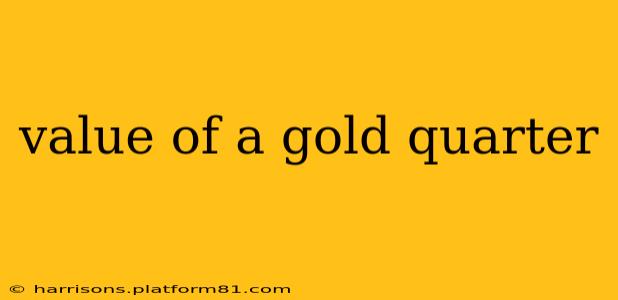The phrase "gold quarter" can be a bit ambiguous. It doesn't refer to a standard US quarter made of gold, as those haven't been minted for circulation since 1932. Instead, it typically refers to one of two things: commemorative gold coins designed to resemble a quarter in size and appearance, or an actual quarter that has been plated or otherwise treated to look like gold. Understanding which type you possess is crucial to determining its value.
What Kind of "Gold Quarter" Do You Have?
This is the most important question to answer before assessing the value of your coin. Here's a breakdown:
1. Commemorative Gold Coins: Many countries have released commemorative coins of varying sizes and gold content. Some might mimic the size and design of a US quarter, but be made entirely of gold. These coins will hold significantly more value than a gold-plated quarter. Their value fluctuates based on:
- Gold Purity (Karat): The higher the karat (e.g., 24K being pure gold), the more valuable the coin.
- Weight: Heavier coins naturally contain more gold, increasing their worth.
- Rarity: Limited-edition or historically significant coins command higher prices.
- Condition: Mint condition coins are worth far more than damaged or worn ones. Scratches, dents, and tarnishing significantly reduce value.
- Current Gold Spot Price: The value of gold fluctuates daily on the international markets. A higher gold price means a higher coin value.
2. Gold-Plated or Gold-Filled Quarters: These are standard US quarters that have been coated with a thin layer of gold or have a gold-filled core. The value here is significantly lower. These are usually novelty items or souvenirs, not investments. Their value is primarily determined by:
- Collectibility: Depending on the design or origin of the plating/filling, it may have slight collector value, though usually minimal.
- Condition: As with any collectible item, the better the condition, the more likely it is to be worth something above its face value.
How to Determine the Value of Your Gold Quarter
1. Identify the Type: Is it a commemorative gold coin or a gold-plated/filled quarter? Examine the coin closely. A true gold coin will likely have hallmarks indicating its purity and the issuing authority. A gold-plated coin, on the other hand, might show signs of the base metal underneath if scratched.
2. Check for Hallmarks: Look for markings that indicate the year of mintage, gold purity (karat), and the issuing country or mint. These markings are crucial for identification.
3. Weigh the Coin: Use a precise scale to determine the weight of the coin. This information, along with the karat, will help determine the amount of gold present.
4. Assess the Condition: Carefully examine the coin for any damage, wear, or tarnishing. Use a grading system (like those used for coin collecting) to help determine its condition.
5. Research Online: Use online resources, coin catalogs, or auction sites to compare your coin to similar items that have been sold recently. Websites specializing in numismatics (coin collecting) are valuable resources.
6. Consult a Professional: For valuable or rare coins, it's best to consult a reputable numismatist or coin appraiser who can provide a professional valuation.
Frequently Asked Questions (FAQs)
Can a gold quarter be worth more than its weight in gold?
Rare commemorative gold coins, due to their rarity and historical significance, can sometimes sell for more than the current value of their gold content. However, this is not typical for a run-of-the-mill gold-plated quarter.
How can I tell if my gold quarter is real gold?
Real gold coins will generally have hallmarks indicating gold content, the issuing authority, and the year of mintage. Look for these markings. You can also consult a numismatist or jeweler to verify its authenticity.
Where can I sell my gold quarter?
You can sell your gold quarter through online auction sites (eBay, etc.), reputable coin dealers, or pawn shops. However, always get multiple appraisals before selling a valuable item.
What is the average price of a gold-plated quarter?
The value of a gold-plated quarter is generally low, usually just slightly above its face value (25 cents), depending on condition and any special features.
Remember, the value of a "gold quarter" depends heavily on its type and condition. Carefully assessing these factors is crucial before attempting to sell or appraise it.
